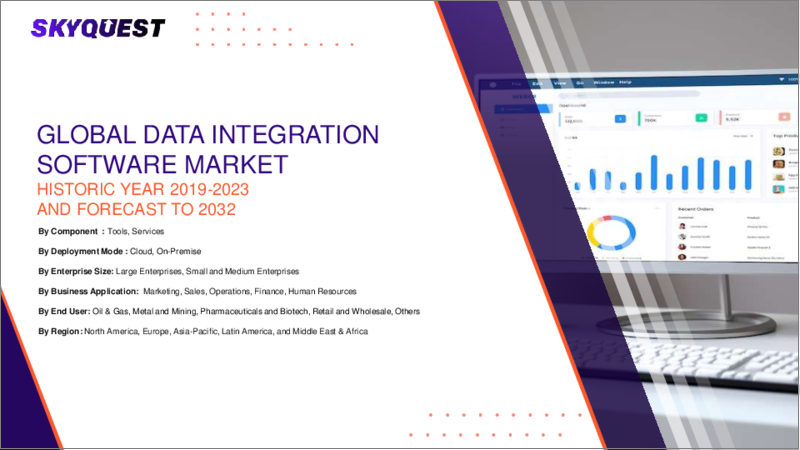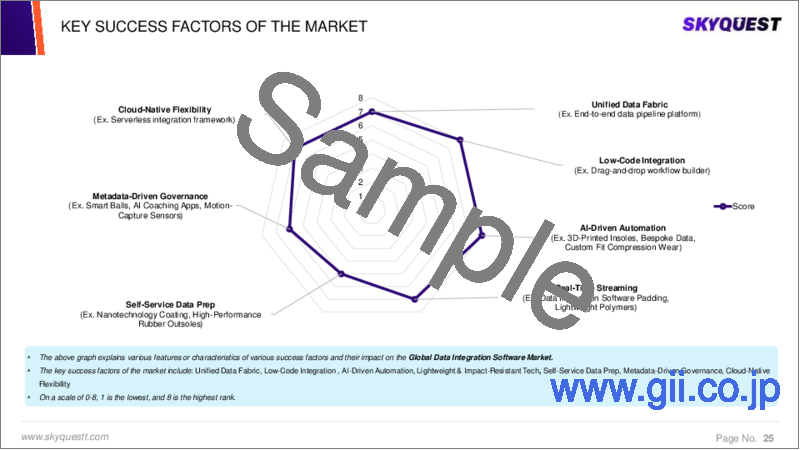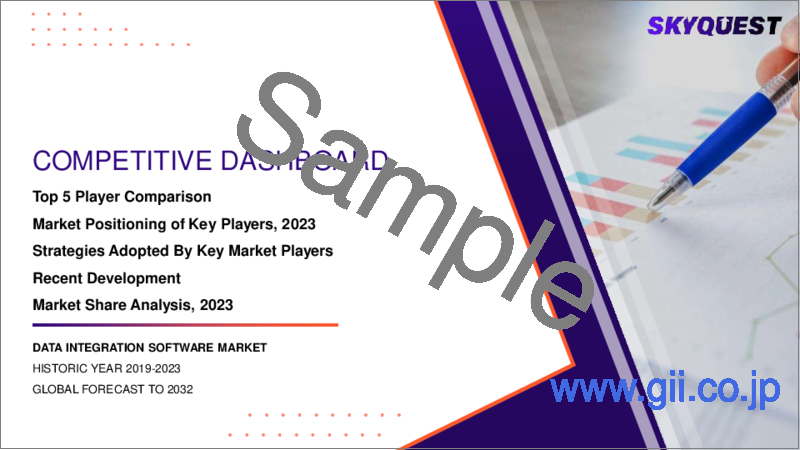|
|
市場調査レポート
商品コード
1628992
データ統合ソフトウェアの市場規模、シェア、成長分析、コンポーネント別、ビジネスアプリケーション別、展開モード別、組織規模別、業種別、地域別 - 産業予測、2025~2032年Data Integration Software Market Size, Share, Growth Analysis, By Component (Tools, Services), By Business Application (Marketing, Sales), By Deployment Mode, By Organization Size, By Vertical, By Region - Industry Forecast 2025-2032 |
||||||
|
|||||||
| データ統合ソフトウェアの市場規模、シェア、成長分析、コンポーネント別、ビジネスアプリケーション別、展開モード別、組織規模別、業種別、地域別 - 産業予測、2025~2032年 |
|
出版日: 2025年01月06日
発行: SkyQuest
ページ情報: 英文 299 Pages
納期: 3~5営業日
|
全表示
- 概要
- 目次
データ統合ソフトウェアの世界市場規模は、2023年に128億米ドルと評価され、2024年の143億7,000万米ドルから2032年には363億6,000万米ドルに成長し、予測期間(2025-2032年)のCAGRは12.3%で成長する見通しです。
データ統合は企業にとって極めて重要な資産として台頭しており、新たな洞察を引き出し、インパクトのあるビジネスインテリジェンスの開発を加速することで、商取引に革命をもたらしています。銀行、金融、保険、通信、ヘルスケアなどの主要セクターは、顧客満足度と業務の合理化を優先しており、効果的なデータ統合の需要を促進しています。クラウドベースのサービスの台頭は、特に新興企業や拡大する企業において、効率的な導入を促進しています。しかし、AI、学習アルゴリズム、ソフトウェア開発の進歩は、新たな課題を提示しています。さらに、COVID-19の大流行はビジネスプロセスを再構築し、既存の弱点を浮き彫りにする一方で、クラウド、AI、IoT、ブロックチェーンなどの技術統合によるデジタルトランスフォーメーションと世界成長の機会を促進しています。データ統合ソリューションが多様な業界の業務効率を高める機運が高まるにつれて、市場はデータ統合ソリューションへの投資を増やす態勢を整えています。
目次
イントロダクション
- 調査の目的
- 調査範囲
- 定義
調査手法
- 情報調達
- 二次データと一次データの方法
- 市場規模予測
- 市場の前提条件と制限
エグゼクティブサマリー
- 世界市場の見通し
- 供給と需要の動向分析
- セグメント別機会分析
市場力学と見通し
- 市場概要
- 市場規模
- 市場力学
- 促進要因と機会
- 抑制要因と課題
- ポーターの分析
主な市場の考察
- 重要成功要因
- 競合の程度
- 主な投資機会
- 市場エコシステム
- 市場の魅力指数(2024年)
- PESTEL分析
- マクロ経済指標
- バリューチェーン分析
- 価格分析
- 技術分析
- 規制分析
- ケーススタディ分析
データ統合ソフトウェア市場規模:コンポーネント別
- 市場概要
- ツール
- サービス
- マネージドサービス
- プロフェッショナルサービス
データ統合ソフトウェア市場規模:ビジネスアプリケーション別
- 市場概要
- マーケティング
- セールス
- オペレーション
- ファイナンス
- 人事
データ統合ソフトウェア市場規模:展開モード別
- 市場概要
- オンプレミス
- オンクラウド
データ統合ソフトウェア市場規模:組織規模別
- 市場概要
- 大企業
- 中小企業
データ統合ソフトウェア市場規模:業界別
- 市場概要
- ヘルスケアとライフサイエンス
- 銀行金融サービス保険
- 製造業
- 小売・消費財
- ITおよび通信
- メディアとエンターテイメント
- エネルギーと公共事業
- 政府と防衛
- その他
データ統合ソフトウェア市場規模
- 北米
- 米国
- カナダ
- 欧州
- ドイツ
- スペイン
- フランス
- 英国
- イタリア
- その他欧州地域
- アジア太平洋地域
- 中国
- インド
- 日本
- 韓国
- その他アジア太平洋地域
- ラテンアメリカ
- ブラジル
- その他ラテンアメリカ地域
- 中東・アフリカ
- GCC諸国
- 南アフリカ
- その他中東・アフリカ
競合情報
- 上位5社の比較
- 主要企業の市場ポジショニング(2024年)
- 主な市場企業が採用した戦略
- 市場の最近の動向
- 企業の市場シェア分析(2024年)
- 主要企業の企業プロファイル
- 会社概要
- 製品ポートフォリオ分析
- セグメント別シェア分析
- 収益の前年比比較(2022-2024)
主要企業プロファイル
- Microsoft
- IBM
- SAP
- Oracle
- SAS Institute
- Talend
- Informatica
- Software AG
- TIBCO
- Hevo
- Denodo Technologies
- Actian
- HVR
- Hitachi Vantara
- Adeptia
- Boomi
- Jitterbit
- OpenText
結論と推奨事項
Global Data Integration Software Market size was valued at USD 12.8 billion in 2023 and is poised to grow from USD 14.37 billion in 2024 to USD 36.36 billion by 2032, growing at a CAGR of 12.3% during the forecast period (2025-2032).
Data integration is emerging as a pivotal asset for businesses, revolutionizing commerce by unlocking new insights and accelerating the development of impactful business intelligence. Key sectors such as banking, finance, insurance, communications, and healthcare prioritize customer satisfaction and streamlined operations, driving the demand for effective data integration. The rise of cloud-based services is facilitating efficient deployments, particularly among startups and expanding firms. However, advancements in AI, learning algorithms, and software development present new challenges. Additionally, the COVID-19 pandemic has reshaped business processes, highlighting existing weaknesses while fostering opportunities for digital transformation and global growth through technology integration, including cloud, AI, IoT, and blockchain. The market is poised for increased investment in data integration solutions as they gain momentum in enhancing operational efficiency across diverse industries.
Top-down and bottom-up approaches were used to estimate and validate the size of the Global Data Integration Software market and to estimate the size of various other dependent submarkets. The research methodology used to estimate the market size includes the following details: The key players in the market were identified through secondary research, and their market shares in the respective regions were determined through primary and secondary research. This entire procedure includes the study of the annual and financial reports of the top market players and extensive interviews for key insights from industry leaders such as CEOs, VPs, directors, and marketing executives. All percentage shares split, and breakdowns were determined using secondary sources and verified through Primary sources. All possible parameters that affect the markets covered in this research study have been accounted for, viewed in extensive detail, verified through primary research, and analyzed to get the final quantitative and qualitative data.
Global Data Integration Software Market Segmental Analysis
Global Data Integration Software Market is segmented by Component, Business Application, Deployment Mode, Organization Size, Vertical and region. Based on Component, the market is segmented into Tools and Services. Based on Business Application, the market is segmented into Marketing, Sales, Operations, Finance and Human Resources. Based on Deployment Mode, the market is segmented into On-Premises and On-Cloud. Based on Organization Size, the market is segmented into Large Enterprises and Small and Medium Enterprises. Based on Vertical, the market is segmented into Healthcare and Life Sciences, Banking, Financial Services, and Insurance, Manufacturing, Retail and Consumer Goods, IT and Telecom, Media and Entertainment, Energy and Utilities, Government and Defense and Others. Based on region, the market is segmented into North America, Europe, Asia Pacific, Latin America and Middle East & Africa.
Driver of the Global Data Integration Software Market
The growing shift towards cloud computing is a significant driver of the Global Data Integration Software market. As organizations increasingly migrate to cloud-based infrastructures and services, the need for effective data integration solutions has expanded. These tools enable businesses to efficiently access, manage, and synchronize data from multiple sources, bridging the gap between on-premises systems and cloud applications. By leveraging data integration software, enterprises can maximize the advantages of cloud technology while ensuring that their data remains consistent and accurate. This demand underscores the pivotal role of data integration as companies strive to optimize their operations in a cloud-centric landscape.
Restraints in the Global Data Integration Software Market
The Global Data Integration Software market faces significant restraints stemming from data security and privacy issues. As organizations increasingly integrate vast volumes and diverse types of data, concerns surrounding potential data breaches, unauthorized access, and data manipulation emerge as critical deterrents to adoption. These risks compel companies to prioritize compliance with data protection regulations while implementing robust data governance and encryption practices. To foster trust and confidence among customers, the data integration software market must effectively address these challenges, ensuring that security measures are in place to protect sensitive information throughout the integration process, thus paving the way for wider acceptance and usage.
Market Trends of the Global Data Integration Software Market
The Global Data Integration Software market is witnessing a significant shift driven by the emergence of advanced technologies such as artificial intelligence (AI) and machine learning (ML). These technologies are increasingly being incorporated into data integration tools to automate tasks like data mapping, cleansing, and transformation, enhancing data quality and reducing manual efforts. Additionally, the rise of data virtualization is transforming the landscape, enabling organizations to access and integrate data in real-time without the need for physical data movement or replication. This trend minimizes redundancy and accelerates insight delivery, positioning data integration software as a critical component for informed business decision-making in an increasingly data-driven world.
Table of Contents
Introduction
- Objectives of the Study
- Scope of the Report
- Definitions
Research Methodology
- Information Procurement
- Secondary & Primary Data Methods
- Market Size Estimation
- Market Assumptions & Limitations
Executive Summary
- Global Market Outlook
- Supply & Demand Trend Analysis
- Segmental Opportunity Analysis
Market Dynamics & Outlook
- Market Overview
- Market Size
- Market Dynamics
- Drivers & Opportunities
- Restraints & Challenges
- Porters Analysis
- Competitive rivalry
- Threat of substitute
- Bargaining power of buyers
- Threat of new entrants
- Bargaining power of suppliers
Key Market Insights
- Key Success Factors
- Degree of Competition
- Top Investment Pockets
- Market Ecosystem
- Market Attractiveness Index, 2024
- PESTEL Analysis
- Macro-Economic Indicators
- Value Chain Analysis
- Pricing Analysis
- Technology Analysis
- Regulatory Analysis
- Case Study Analysis
Global Data Integration Software Market Size by Component & CAGR (2025-2032)
- Market Overview
- Tools
- Services
- Managed Services
- Professional Services
Global Data Integration Software Market Size by Business Application & CAGR (2025-2032)
- Market Overview
- Marketing
- Sales
- Operations
- Finance
- Human Resources
Global Data Integration Software Market Size by Deployment Mode & CAGR (2025-2032)
- Market Overview
- On-Premises
- On-Cloud
Global Data Integration Software Market Size by Organization Size & CAGR (2025-2032)
- Market Overview
- Large Enterprises
- Small and Medium Enterprises
Global Data Integration Software Market Size by Vertical & CAGR (2025-2032)
- Market Overview
- Healthcare and Life Sciences
- Banking, Financial Services, and Insurance
- Manufacturing
- Retail and Consumer Goods
- IT and Telecom
- Media and Entertainment
- Energy and Utilities
- Government and Defense
- Others
Global Data Integration Software Market Size & CAGR (2025-2032)
- North America (Component, Business Application, Deployment Mode, Organization Size, Vertical)
- US
- Canada
- Europe (Component, Business Application, Deployment Mode, Organization Size, Vertical)
- Germany
- Spain
- France
- UK
- Italy
- Rest of Europe
- Asia Pacific (Component, Business Application, Deployment Mode, Organization Size, Vertical)
- China
- India
- Japan
- South Korea
- Rest of Asia-Pacific
- Latin America (Component, Business Application, Deployment Mode, Organization Size, Vertical)
- Brazil
- Rest of Latin America
- Middle East & Africa (Component, Business Application, Deployment Mode, Organization Size, Vertical)
- GCC Countries
- South Africa
- Rest of Middle East & Africa
Competitive Intelligence
- Top 5 Player Comparison
- Market Positioning of Key Players, 2024
- Strategies Adopted by Key Market Players
- Recent Developments in the Market
- Company Market Share Analysis, 2024
- Company Profiles of All Key Players
- Company Details
- Product Portfolio Analysis
- Company's Segmental Share Analysis
- Revenue Y-O-Y Comparison (2022-2024)
Key Company Profiles
- Microsoft
- Company Overview
- Business Segment Overview
- Financial Updates
- Key Developments
- IBM
- Company Overview
- Business Segment Overview
- Financial Updates
- Key Developments
- SAP
- Company Overview
- Business Segment Overview
- Financial Updates
- Key Developments
- Oracle
- Company Overview
- Business Segment Overview
- Financial Updates
- Key Developments
- SAS Institute
- Company Overview
- Business Segment Overview
- Financial Updates
- Key Developments
- Talend
- Company Overview
- Business Segment Overview
- Financial Updates
- Key Developments
- Informatica
- Company Overview
- Business Segment Overview
- Financial Updates
- Key Developments
- Software AG
- Company Overview
- Business Segment Overview
- Financial Updates
- Key Developments
- TIBCO
- Company Overview
- Business Segment Overview
- Financial Updates
- Key Developments
- Hevo
- Company Overview
- Business Segment Overview
- Financial Updates
- Key Developments
- Denodo Technologies
- Company Overview
- Business Segment Overview
- Financial Updates
- Key Developments
- Actian
- Company Overview
- Business Segment Overview
- Financial Updates
- Key Developments
- HVR
- Company Overview
- Business Segment Overview
- Financial Updates
- Key Developments
- Hitachi Vantara
- Company Overview
- Business Segment Overview
- Financial Updates
- Key Developments
- Adeptia
- Company Overview
- Business Segment Overview
- Financial Updates
- Key Developments
- Boomi
- Company Overview
- Business Segment Overview
- Financial Updates
- Key Developments
- Jitterbit
- Company Overview
- Business Segment Overview
- Financial Updates
- Key Developments
- OpenText
- Company Overview
- Business Segment Overview
- Financial Updates
- Key Developments






